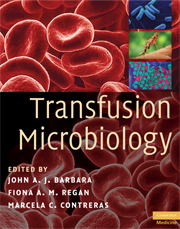Book contents
- Frontmatter
- Contents
- List of contributors
- Foreword
- Preface
- Acknowledgements
- Glossary
- Introduction: Transfusion-transmitted infections, then and now
- Section 1 Agents
- Section 2 Selection and testing
- Section 3 Surveillance, risk and regulation
- 21 Serious hazards of transfusion (SHOT); haemovigilance
- 22 Investigation of post-transfusion infection
- 23 Notification of donors with significant microbiological test results
- 24 Researching the natural history of transfusion-transmitted infections: the UK hepatitis C (HCV) national register
- 25 How to assess risk: prospective studies and calculations
- 26 Risk management
- 27 The regulatory environment in Europe
- 28 Blood safety in developing countries
- Index
- Plate section
- References
28 - Blood safety in developing countries
from Section 3 - Surveillance, risk and regulation
Published online by Cambridge University Press: 12 January 2010
- Frontmatter
- Contents
- List of contributors
- Foreword
- Preface
- Acknowledgements
- Glossary
- Introduction: Transfusion-transmitted infections, then and now
- Section 1 Agents
- Section 2 Selection and testing
- Section 3 Surveillance, risk and regulation
- 21 Serious hazards of transfusion (SHOT); haemovigilance
- 22 Investigation of post-transfusion infection
- 23 Notification of donors with significant microbiological test results
- 24 Researching the natural history of transfusion-transmitted infections: the UK hepatitis C (HCV) national register
- 25 How to assess risk: prospective studies and calculations
- 26 Risk management
- 27 The regulatory environment in Europe
- 28 Blood safety in developing countries
- Index
- Plate section
- References
Summary
General introduction
When compared with the standards of most developed countries, blood transfusion in developing countries is generally considered not to be as safe. This belief has led some organizations to set up a transfusion supply to Westerners travelling in developing countries. In the past decade, due to both the efforts of WHO and the political determination of some governments, blood products prepared in many countries with a medium development index have reached a level of safety meeting the highest standards.
While blood safety is considered of paramount importance, blood supply remains the priority in the developing world. In developed countries, the number of units of blood collected per 1000 inhabitants ranges between 30 and 75 units, whereas in developing countries it ranges between 1 and 15. As a result of this limited supply, indications for transfusion are limited to severe anaemia with a transfusion trigger often set at a haemoglobin of 5 g/dl. In addition, the lack of resources and technology to perform bone marrow or organ transplantation limits the demand for platelet concentrates and either whole blood or plasma-depleted red cells are the main products transfused.
Despite the fact that blood for transfusion is in limited supply, it is critical that the available blood is safe, but achieving this objective is hampered by a broad range of problems specific to the developing world, which represents 80% of the world population.
- Type
- Chapter
- Information
- Transfusion Microbiology , pp. 369 - 380Publisher: Cambridge University PressPrint publication year: 2008
References
- 1
- Cited by



